日本
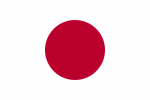
Japan
Quick reference
General issues: Empire 1871-1945, Empire under Allied supervision 1945-1952, Empire 1952-Present
Country name on general issues: Imperial Japanese Post, Nippon, Japan in Japanese characters
Special issues:
- Offices abroad: China 1900-1922, Korea 1900-1901
- Occupation issues WWII
- Andaman & Nicobar Islands 1942-1945
- Burma 1942-1945:
- Burma Independence Army: Henzada issues 1942, Myaungmya issues 1942, Pyapon issues 1942
- Japanese administration 1942, Japanese administration/Shan States 1943
- China 1941-1945:
- Kwangtung: General issues 1942-1945, Canton 1945, Swatow 1945
- Mengkiang 1941-1945
- North China: General issues 1941-1945, Provincial issues 1941-1945: Honan, Hopeh, Shansi, Shantung, Supeh
- Nanking government 1941-1945
- Hong Kong 1945
- Malaya 1942-1945: Straits Settlements, Johore, Kedah, Kelantan, Malacca, Negri Sembilan, Pahang, Penang, Perak, Selangor, Trengganu, Malayan Postal Union
- Netherlands Indies 1942-1945:
- Java 1943-1945
- Sumatra: Local issues 1942-1943, General issues 1943-1945
- Naval Control Area: Local issues 1942-1943, General issues 1943-1945
- North Borneo 1942-1945, North Borneo/Brunei 1942-1945, North Borneo/Sarawak 1942-1945
- Philippines 1942-1945: Japanese administration 1942-1943, Second Philippine Republic 1943-1945
- Japanese administration of Formosa
- Australian forces in Japan 1946-1947
- Prefecture issues 1989-Present
Related issues:
- Azad Hind 1943
- Thai occupation of Malaya 1943
Currency: 1 Sen = 100 Mon 1871, 1 Yen = 100 Sen, 1 Sen = 10 Rin 1871-Present
Population: 43 847 000 in 1900, 127 300 000 in 2013
Political history Japan
Modernizing Japan
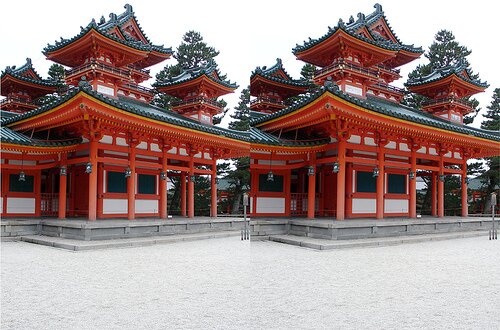
Heian Jingu Temple, Kyoto
Japan is an empire consisting of a group of islands located in eastern Asia. Until the mid 19th century, Japan is a feudal state, almost entirely closed from foreign influences. Under pressure of mainly the United States, Japan is forced to open up from the 1850’s. Japan makes concessions to a number of foreign powers with respect to diplomatic and trade relations. In 1869, emperor Meiji ascends to the throne and starts what in Japanese history is called the ‘Meiji restoration’. Japan in the coming years is transformed from a feudal state into a centrally governed empire with a modern economy and a powerful military.
The first steps on the road of expansion
Along with the modernization of Japan, a period of continuous expansion starts in the late 19th century. In 1875, a treaty is signed with Russia by which Japan acquires the Kurile Islands to the north of Japan. In exchange, Japan relinquishes its claims on the Sakhalin peninsula. South of Japan, the Ryukyu Islands, in the 19th century, are tributary to both China and Japan. The Ryuku Islands are unilaterally annexed by Japan in 1879.
The First Sino-Japanese War
In 1894, Japan starts the First Sino-Japanese war. The aim being mainly to bring Korea within the Japanese sphere of influence. In 1895, China and Japan sign a peace agreement in which China relinquishes its claims on Korea. Furthermore, China cedes Formosa and acknowledges the Japanese annexation of the Ryukyu Islands. In 1900, Japan is one of the eight countries to form the international coalition that invades China to quell the Boxer rebellion, and to ensure the continuation of the extraterritorial rights of foreign powers in China.
The Russo-Japanese War
The next step in Japanese expansion is the Russo-Japanese war in 1904-1905. The cause being the increasing influence of Russia in Manchuria. Russia occupied Manchuria in 1901 during the international invasion of China to suppress the Boxer rebellion, and in subsequent years has enforced its position in Manchuria. In the Russo-Japanese war the Japanese show military superiority. In the 1905 peace agreement, Russia withdraws from Manchuria that now becomes part of the Japanese sphere of influence. As a further result of the war, Russia withdraws from Korea, that in 1905 becomes a Japanese protectorate and in 1910 is annexed by Japan to become an integral part of the Japanese empire. Finally, Russia cedes the southern part of Sakhalin – acquired by Russia in 1875 – to Japan. The Russo-Japanese war puts Japan on the map as a military power to be acknowledged.
World War I
In WWI, Japan sides with the Allies and attacks the German leased territory of Kiaochow in China and the German colonies in the Pacific Ocean. At the end of WWI, the Caroline, Mariana and Marshall Islands are entrusted to Japan as mandated territories.
Invading Manchuria
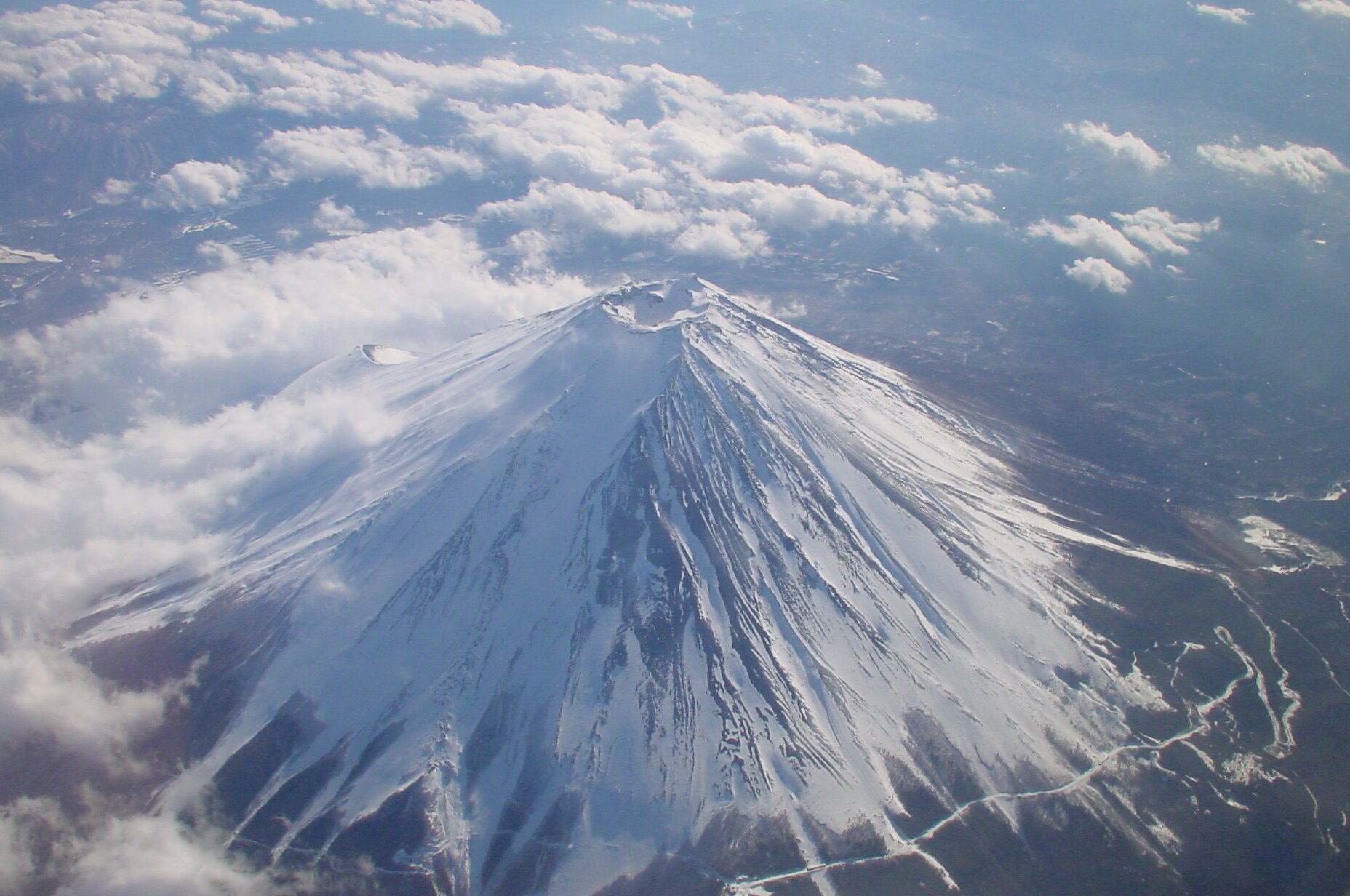
Mount Fuji
Japanese expansion continues with the invasion of Manchuria in 1931. Japanese interests in Manchuria already being substantial, Japan now aims to gain full control over the industrial potential of Manchuria. A potential that has to serve Japan in its plan for further expansion. The Japanese in Manchuria form the nominally independent empire of Manchukuo and put the last heir of the Chinese Qing dynasty on the throne. The territory of Manchukuo is further extended in 1933 when the Chinese province of Rehe is annexed. The invasion in Manchuria is met with strong international opposition that results in Japan withdrawing from the League of Nations in 1936.
The Second Sino-Japanese War
In 1937, Japan initiates the Second Sino-Japanese war. Japan, between 1937 and 1942, conquers parts of Inner Mongolia, North, Central and South China. To administer the conquered territories, Japan sets up nominally independent governments along the lines of the Japanese military command structure. Thus, local governments are formed in Menkiang – Inner Mongolia, North China, Central China and Kwangtung – South China. In 1940, these are formally subordinated to the National Government seated in Nanking. De facto the local governments retain a large amount of self government.
World War II
In the advance of WWII Japan allies itself with the Axis powers – Germany and Italy. Japan, furthermore, signs a neutrality pact with Russia that will last until 1945. Then, in 1940, Japan invades Tonkin in French Indochina. Sanctions applied by the United States as a reprisal for the invasion lead to increased tension between Japan and the United States. In 1941, Japan attacks Pearl Harbour in Hawaii: both Japan and the United States enter WWII. Subsequently, Japan conquers large parts of southeast Asia and the Pacific.
Japanese rule in the occupied territories
The Japanese establish different forms of government in the occupied territories depending on the local context. In French Indochina, the French colonial administration – loyal to the Vichy regime – is largely left in place under Japanese supervision. In, for example, Burma and the Philippines, Japan forms nominally independent local governments with the support of local movements aiming at independence. Other territories are under direct Japanese military or civil administration. Parts of the occupied territories are transferred to Thailand – allied to Japan.
Japanese rule in the occupied territories: a closer look
A closer look at the administration of the territories occupied by Japan:
- Andaman & Nicobar Islands. The British Indian Andaman & Nicobar Islands are occupied by Japan in 1942. After a period of Japanese administration, the administration of the islands is transferred to Azad Hind. Azad Hind was an Indian nationalist movement that had sought and found the support of the Axis powers in their strive for an independent India. In Thailand, with Japanese support, the Provisional Government of Free India – Azad Hind – was set up to which the administration of the Andaman & Nicobar Islands is nominally transferred in 1943.
- Brunei, Labuan, North Borneo and Sarawak. The British protectorates on Borneo are occupied by Japan in late 1941, early 1942. Brunei, North Borneo and Sarawak are grouped together by Japan to form the administrative area of North Borneo. Labuan – governed by the British as part of the Straits Settlements – equally becomes part of the North Borneo administrative area.
-
Burma. Burma is occupied by Japan in 1942. In this, Japan is supported by Burmese nationalists that, in the advance of WWII, with Japanese support have formed the Burma Independence Army. In 1943, the Japanese form the nominally independent State of Burma, in which the Burma Independence Army is incorporated. Part of the Shan states – states with a special status throughout Burmese history – are put under Thai administration.
- French Indochina. French Indochina is occupied by Japan during of 1940 and 1941. The Japanese leave the French colonial administration – loyal to the Vichy regime – largely in place. Parts of Cambodia and Laos that have been ceded by Thailand in 1904 and 1907 are put under Thai administration. In 1945, the Japanese establish the nominally independent kingdom of Cambodia and the empire of Vietnam. The king of Laos – also part of French Indochina – refuses cooperation with the Japanese for the establishment of an independent Laos.
- Gilbert Islands, Nauru and the Solomon Islands. The British Gilbert and Solomon Islands and the British-Australian-New Zealand mandated territory of Nauru were occupied by Japan in 1942 as part of the envisaged defensive perimeter around Japan of which bases in the Pacific formed a part. The Solomon Islands were one of the first objectives in the Allied counter attack, the battle of Guadalcanal in 1942 being one of the major battles in the Pacific theater of war. Many of the islands in the region were, however, bypassed and were occupied until 1945.
- Guam and Wake Island, Attu and Kiska Islands. Guam and Wake Island were United States military bases in the Pacific and, as such, primary targets in the Japanese offensive in the Pacific directly following the attack on Pearl Harbour in 1941. Guam was occupied until 1944, Wake Island until 1945. The Attu and Kiska Islands are scarcely populated United States islands, part of the Aleutian Islands of Alaska. The Japanese occupied the islands in 1942 with future strategic goals in mind. The islands were freed in 1943.
- Hong Kong. British Hong Kong is occupied by Japan in 1941. A military administration is installed, Hong Kong being under martial law for the duration of the occupation. Nearby Portuguese Macau is not occupied during WWII, due to the fact that Portugal is a neutral country in WWII.
-
Malaya. The British possessions on the Malayan peninsula are invaded by Japan in 1941 and occupied from 1942 – both the Straits Settlements and the Malayan States. Those Malayan States that have been tributaries to Thailand until 1909 are, in 1943, put under Thai administration.[1]Kedah, Kelantan, Perlis and Trengganu. The Japanese form the administrative area of Malaya to administer the Straits Settlements and the Malayan States. Labuan – an island off the coast of Borneo and, at the time, governed by the British as part of the Straits Settlements – is also occupied by Japan and administered as part of the administrative area of North Borneo. The more remote Christmas Island in the Indian Ocean – also administered by the British as part of the Straits Settlements – is equally occupied by Japan while the Cocos Islands – also located in the Indian Ocean and governed by the British as part of the Straits Settlements – are not.
- Netherlands Indies. The Netherlands Indies are occupied by Japan in 1942. The Japanese form three administrative areas in Netherlands Indies: Java and Sumatra – initially part of the Malaya administrative area – are administered as army areas, the rest of the Netherlands Indies are grouped together to form the Naval Control Area which is administered by the navy. The Riau Islands are, for the duration of the Japanese occupation, part of the Malaya district.
- New Guinea. The Australian mandated territory of New Guinea was occupied by Japan in 1942, upon which the Japanese installed military administration in New Guinea. The larger part of Dutch New Guinea was equally occupied as part of the Netherlands Indies. Papua escaped from Japanese occupation.
- Philippines. The Philippines – a United States Commonwealth territory at the time – are invaded in 1941 and occupied by Japan during 1942. Here too, the Japanese support the nationalist factions to set up a nominally independent republic – the Second Philippine Republic – in 1943. The first Allied forces land in the Philippines in 1944, all of the Philippines to be returned to United States rule in 1945.
- Portuguese Timor. Portugal being neutral in WWII, Portuguese Macau was not occupied by Japan. Portuguese Timor was possibly involved in the war because, in 1941, Australian and Dutch forces had landed on the island to protect it from a Japanese attack. The Japanese occupied the island in 1942-1943.
World War II: turning the tide
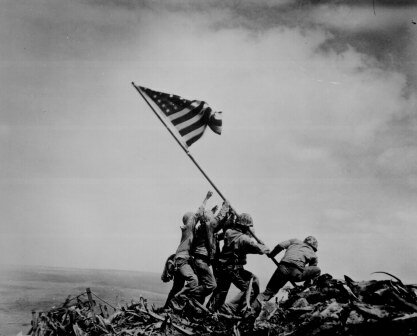
1945 – Iwo Jima
A turning point in the war is the Battle of Midway, in June 1942, where the Allies, for the first time, decisively defeated the Japanese Navy. The long supply lines in the extended Japanese empire and the much larger arms production capacity of the United States make the Allies gain the upper hand in the war. In 1945, Russia breaks the neutrality pact and joins the Allies in the fight against Japan. After the nuclear attack on Hiroshima and Nagasaki, Japan decides to capitulate in 1945.
The aftermath of the war
After capitulation, Japan is occupied by the Allies. The United States are in the lead, supported by the ‘British Commonwealth Occupation Force’, consisting of forces from several parts of the British Commonwealth. The Japanese empire is downsized to what it was in 1895 at the start of the Japanese expansion. The actual transfer of power to the appointed ruling countries will take until 1946, often with an intermediary phase of occupation by the Allies. The Allied occupation of the Japanese mainland ends in 1952 when the peace treaty with Japan is signed. An exception are the Ryukyu islands, that are in part returned in 1952, in 1953 and in 1972. On Okinawa the United States will have one of their largest air force bases, the base being of importance during the Cold War. The Kurile Islands, are after the war, annexed by Russia which is still an issue between Japan and Russia.
After WWII, Japan, supported by the United States, develops into a modern democracy and an economic world player.
Postal history Japan
General issues
A postal service for official government mail goes back a long time in Japan. In 1871, this service is opened for the general public and the first stamps are issued. As the Japanese empire extends, so does the postal service. Japanese stamps are used most notably on Formosa from 1895, in Korea from 1905 and in the former German colonies in the Pacific – the Caroline, Mariana and Marshall Islands – from 1914.
Offices abroad
As Japan opens up to foreign powers, these foreign powers open offices abroad in Japan: France has an office in Yokohama from 1865 until 1880 where French stamps are used, Great Britain has three offices in Kobe, Nagasaki and Yokohama from 1859 until 1879 where, from 1864, stamps from Hong Kong are used and the United States have offices in Hakodate, Kobe, Nagasaki and Yokohama from 1867 until 1874 where United Sates stamps are used.
Japan itself also has offices abroad. These being in China from 1876 until 1922 and in Korea from 1876 until 1905. In the offices in China and Korea Japanese stamps are used until, from 1900, Japan issues stamps specifically for use in the offices in China and Korea. These being Japanese stamps with overprints in Japanese reading ‘China’ and ‘Korea’. Please refer to the ‘China, Empire‘ country profile for a map of the Japanese offices in China.
Once Korea becomes a Japanese protectorate in 1905, the postal services in Korea are fully integrated with those of the Japanese empire and, subsequently, Japanese stamps are used in Korea until 1945.
Issues for the occupied territories in WW II
Just as the way in which the occupied territories are administered by the Japanese is diverse, so is the use of stamps in the occupied territories. In some parts Japanese stamps are used. In other parts the Japanese administration issues stamps. These may be overprints on previous local issues or definitives – including commemoratives – of Japanese design. Stamps have been issued through nominally independent governments as they were set up by the Japanese. Finally, stamps as issued by the local authorities may have been in continued use during the Japanese occupation.
Issues for the occupied territories in WWII: a closer look
A closer look at the stamps issued for the territories occupied by Japan in WWII:
- Andaman & Nicobar Islands: Issued in 1942, overprints are listed in Michel for use on the Andaman & Nicobar Islands. These being issues from British India overprinted with a new face value in the Japanese military currency – a currency Japan issued for its military and, in some occasions, forced on the local populations of the occupied territories. Subsequently, as the Andaman & Nicobar Islands were nominally transferred to Azad Hind, stamps were prepared by Azad Hind for use on the islands. The stamps were printed in Germany but never actually used on the islands.[2]Both the issues from the Japanese administration and from Azad Hind are only listed in the Michel catalog.
-
Brunei, Labuan, North Borneo and Sarawak: The British possessions on Borneo were grouped together in the administrative area of North Borneo. Available stamps from Brunei, North Borneo and Sarawak were overprinted in Japanese and were valid throughout the administrative area of North Borneo. The overprints would read ‘Imperial Japanese Government’ on stamps of Brunei, North Borneo or Sarawak and ‘Imperial Japanese Post North Borneo’ or just ‘North Borneo’ on stamps from North Borneo. The overprints exist in several varieties and in different colors as the overprint was applied both by the central authorities and by local post offices. Two sets of Japanese design have been issued in 1943.[3]The overprint ‘Imperial Japanese Government’ is known to exist on stamps of the Straits Settlements used in Labuan. Michel states that the status of the issues is not clear and they are not listed in the catalogs.
- Burma: Following the Japanese occupation of Burma, stamps are issued both by the Burmese Independence Army and the Japanese administration. In 1942, the stamps of the Burmese Independence Army are locally issued in the cities of Henzada, Myaungmya and Pyapon. These issues are Burmese stamps with the overprint of a peacock, the national symbol of Burma also seen on some regular issues of Burma. As of 1943, stamps are issued in the name of the State of Burma. In 1943, stamps are issued specifically for use in the Shan States – throughout the history of Burma states with a special status.
-
China: After Japan has conquered parts of China, from 1937 on the local governments installed in Kwangtung, Mengkiang and North China issue stamps as of 1940. The National Government installed in Nanking also issues stamps as of 1940 – used in the provinces in Central China actually under its control. The North China government issues stamps on a general and a provincial level, the provinces being Honan, Hopeh, Shansi, Shantung and Supeh[4]Supeh is the northern part of the Chinese province of Kiangsu. . In Kwangtung local issues appear in 1945 for use in Canton and Swatow. The stamps issued are, for the better part, overprints on stamps of the republic of China. Some overprints have a commemorative character such as overprints for the surrender of Singapore to the Japanese and the 10th anniversary of the establishment of Manchukuo. Mengkiang, North China and the Nanking Government have also issued definitives of their own design. The overprints would generally be the name of the region in which the stamps were to be used.
- French Indochina: In French Indochina the French colonial administration was left in place and so was the postal service. Stamps issued by the colonial administration have been used throughout the Japanese occupation of French Indochina.
- Hong Kong: In Hong Kong Japanese stamps were in use. In 1945, Japanese stamps with an overprint of a new face value were issues for use specifically in Hong Kong.
-
Malaya: The Straits Settlements and the Malayan States were grouped together in the Malaya administrative area and so was the postal service. To the Malaya administrative area were added the Riau Islands off the coast of Singapore and – for a time in 1942 – Sumatra, both part of he Netherlands Indies. Available stamps were overprinted and – though maybe overprinted locally – valid for use throughout the Malaya administrative area. Thus, overprints are found on stamps of the Straits Settlements, Johore, Kedah, Kelantan, Negri Sembilan, Pahang, Penang, Perak, Selangor, Trengganu, and the Malayan Postal Union. A first series of overprints uses the seal of the Malayan military postal authorities in Japanese. A second series of overprints is in Latin script reading ‘Dai Nippon 2602 Malaya'[5]Dai Nippon stands for ‘Greater Japan’ and 2602 is 1942 in the Japanese calendar. . A third series of overprints is again in Japanese and reads ‘Greater Japanese Post’. Aside from these three generic overprints that have been applied in most of the Malayan states, more specific overprints exist in the individual states – including the settlements of Malacca and Penang – for example, using the seal of the governor or an additional overprint of a new face value. In 1943 and 1944, stamps of Japanese design were issued in addition to the overprints.
- Netherlands Indies: The Netherlands Indies are split up into three administrative areas: Java, Sumatra and the Naval Control Area. The Riau Islands are transferred to the Malaya administrative area. On Java, initially, stamps of the Netherlands Indies continued to be used, albeit only those stamps that did not show the portrait of the queen of the Netherlands. On Sumatra and in the Naval Control Area local overprints on issues of the Netherlands Indies would be used. These overprints were applied locally and exist in many forms. On Sumatra the stamps of the administrative area of Malaya were, in addition, used in 1942 when Sumatra was part of the Malaya administrative area. Finally, stamps of Japan are found to be used in the Netherlands Indies. As of 1943, definitives of Japanese design and inscribed in Japanese are issued for Java, Sumatra and the Naval Control Area respectively.
- Philippines: The Japanese administration issues stamps for the Philippines as of 1942. These are Philippine stamps overprinted with bars and a new face value, later with overprints in Japanese and definitives in Japanese. As of 1943, stamps are issued by the Second Philippine Republic. These bear the name of the country in Latin script: Pilipinas.
In other territories occupied by Japan, the stamps of Japan would be used. Manchukuo issued stamps of its own.
Issues after WWII
Japan continues to issue stamps for general use directly after WWII. The Japanese administration in Formosa – active from the capitulation of Japan in August 1945 until October 1945 – issues stamps for use on the island to supersede the stamps of Japan. These again are superseded later in 1945 by the stamps of the republic of China. Australia issues stamps in 1946 and 1947 for use by the Australian forces that are part of the British Commonwealth Occupation Force, these being overprints on Australian stamps reading ‘B.C.O.F. Japan 1946’. The United States issue separate stamps for use on the Ryukyu Islands until they are returned to Japan in 1972.
Prefecture issues – Furusato issues
From 1989, Japan has issued the so called ‘prefecture’ or ‘furusato’ issues. To understand the prefecture issues it is useful to know more about the administrative divisions in Japan. Japan is organized in 47 prefectures – hence the name of the issues. The prefectures are grouped together by Japan Post in regions. Japan, until 2005, counted 12 postal regions, since 2005 there are 13 regions.
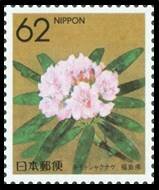
1990 – Prefecture issue for the Fukushima prefecture. Note the font used for prefecture issues, until 2007, in the ‘Nippon Yubin’ inscription on the bottom left and the name of the prefecture in three characters on the bottom right. Please click on the image to enlarge.
The prefecture issues can probably best be described as stamps issued to promote the prefectures. Most stamps promote one prefecture, some two or three prefectures. The stamps are issued by the Japan Post and are valid for use throughout Japan. They are released to the public, however, primarily on the regional level: they are generally available only in the prefectures of the region to which the prefecture for which a stamp is issued belongs. Outside that region they have limited availability – in the early years of the prefecture issues, only at the Tokyo main post office, currently, in the main post offices of all other prefectures. Thus, the prefecture issues can be qualified as somewhere in between national and local issues.
The prefecture issues are released in sets in which all stamps are issued for one specific prefecture, and in sets in which stamps are issued for several prefectures – these mostly being within one region.
To identify the prefecture issues, three elements in the design are of importance. First, the prefecture issues can, until 2007/2008, be distinguished from the national issues by the different font that is used for the ‘Nippon Yubin’ or ‘Japan Post’ inscription in Japanese characters. Second, the prefectures issues are inscribed with the name of the prefecture or prefectures for which they are issued – a string of three or four Japanese characters. Third, all prefecture issues can be identified by their design as they are all of a different design.[6]The prefecture issues are listed in the worldwide catalogs, either in a separate section – Scott and Stanley Gibbons – or in between the national issues – Michel and Yvert & Tellier.
The prefecture issues are an important part of the stamp output of Japan: between 1989 and 2007 Japan has issued some 800 prefecture stamps compared with some 1 100 national issues.
Album pages
← Previous page: IsraelNext page: Jordan →

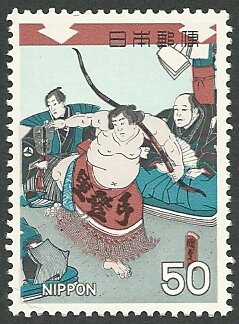
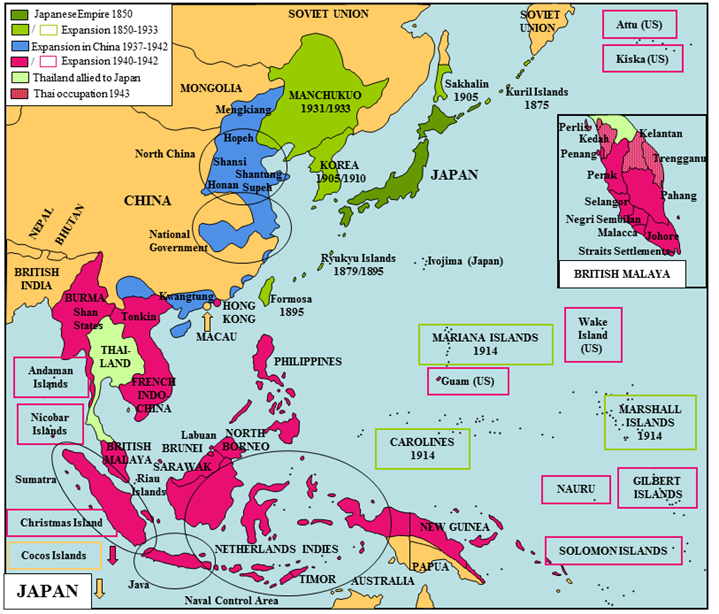
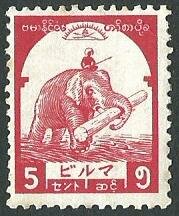
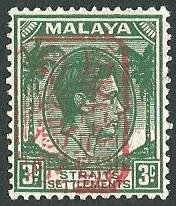
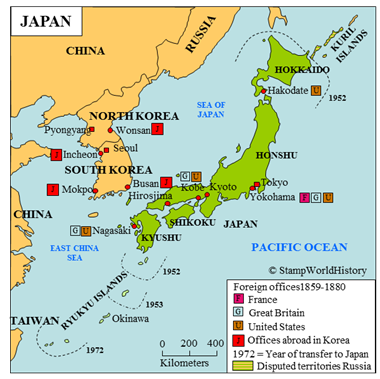
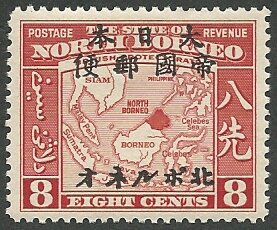
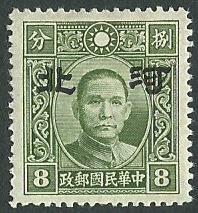
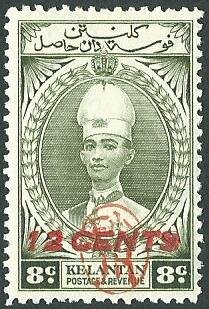
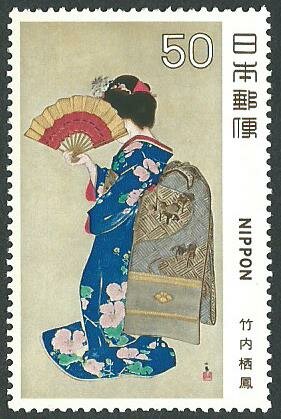
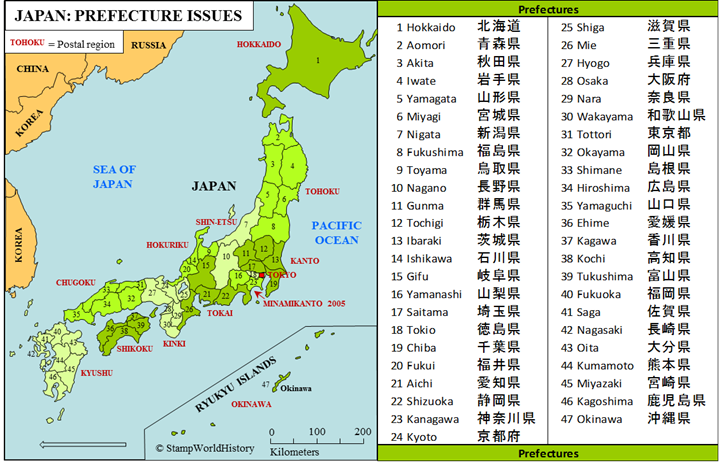



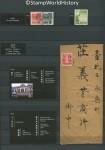
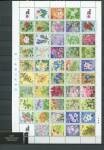
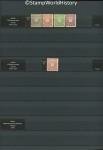


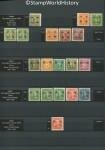
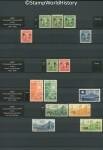

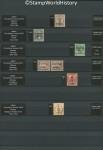
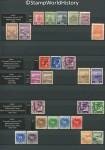



Dear Gerben, I send some information about Japan Furusato stamps. Most of this information is received from Japan. Perhaps you will find something for your website.
The Furusato stamps were issued (data ~2009) not by Japan post and not by prefectures, these stamps were issued by post regions (districts). Each post region issued stamps for his prefectures.
There were 12 post regions in Japan till 2005. Kanto post region was divided in two post regions (Kanto and Minamikanto) in 2005. So now there are 13 post regions (data of ~2009).
The Furusato stamps are given in seperate section in Scott catalogue, and in common order in Michel and Yvert catalogues (with the remarks prefecture stamp or regional stamp).
The Furusato stamps were sold (data ~2009) by all posts of prefecture for what the stamps were issued and by few post offices in all other prefectures.
The stamps for two-three prefectures are issued, so the inscriptions of two or three prefectures are on the stamps.
Gedi
Gedi
Thanks for this additional information. Do you have any more on the postal regions in Japan? I’ve seen them mentioned before but I have not so far been able to find anything more about them.
I send some information about Japan prefecture stamps. I have more information, but I can‘t send it to you – this information is as scans and I don’t have your proper e-address.
POSTAL REGIONS AND THEIR PREFECTURES
Stamps for 2-3 prefectures are given.
Years of issues (till 01 Oct 2007) are shown.
Regions are in bold font.
HOKAIDO
HOKAIDO
HOKURIKU
FUKUI
ISHIKAWA
TOYAMA
FUKUI+ISHIKAWA+TOYAMA (2005)
KANTO
GUNMA
IBARAKI
YAMANASHI
KANAGAWA
SAITAMA
CHIBA
TOCHIGI
KANAGAWA+CHIBA (1997)
KINKI
HYOGO
KYOTO
NARA
OSAKA
SHIGA
WAKAYAMA
KYUSHU
FUKUOKA
KAGOSHIMA
KUMAMOTO
MIJAZAKI
NAGASAKI
OITA
SAGA
OKINAWA
OKINAWA
MINAMIKANTO
YAMANASHI
KANAGAWA
SHIKOKU
EHIME
KAGAWA
KOCHI
TOKUSHIMA
EHIME (SHIKOKU) + HIROSHIMA (CHUGOKU) (1999)
SHIN-ETSU
NAGANO
NIIGATA
CHUGOKU
HIROSHIMA
YAMAGUCHI
OKAYAMA
SHIMANĖ
TOTTORI
OKAYAMA+HIROSHIMA (1999)
TOHOKU
AKITA
AOMORI
FUKUSHIMA
IVATE
YAMAGATA
MIYAGI
AKITA+YAMAGATA (2007)
YAMAGATA+MIYAGI (2007)
TOKAI
ACHI
GIFU
MIE
SHIZUOKA
TOKYO
TOKYO
Gedi
e-post changed the text of my previous message, it became unclear, so I send you the list of Japan post districts.
Hokaido / Tohoku / Kanto / Minamikanto / Shikoku / Hokuriku / Tokai / Kinki / Chugoku / Shin-Etsu / Kyushu / Okinawa.
Gedi
Gedi
Great. Give me some time to see how I can work this into the profile of Japan. I should think adding the regions to the map with the prefectures would be interesting. I would certainly be interested in the scans so I have sent you an email with my email address. As you can see I sort of managed to retrieve the original set up of your previous reply – although the editor for comments has limited possibilities to make a proper list I think the message is clear.